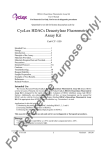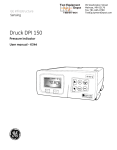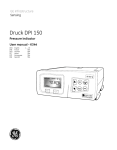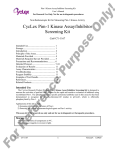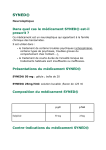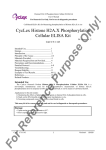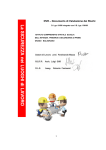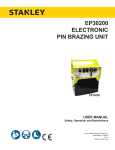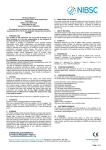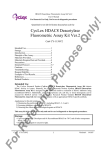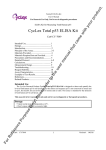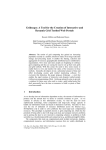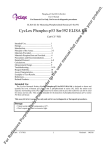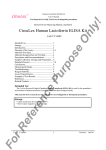Download CY-1140
Transcript
t. uc od ur pr Cellular Histone Acetylation Assay Kit User’s Manual For Research Use Only, Not for use in diagnostic procedures ith yo Cell-Based ELISA Kit for Measuring Acetylation of Histones in situ ca m ew CycLex Cellular Histone Acetylation Assay Kit al an u rm se rt o th eu Intended Use................................................ 1 Storage......................................................... 1 Introduction.................................................. 2 Principle of the Assay.................................. 2-3 Materials Provided....................................... 4 Materials Required but not Provided........... 4 Precautions and Recommendations.............. 5 Detailed Protocol.......................................... 6-9 Troubleshooting............................................ 9 Reagent Stability........................................... 9 Example of Test Results............................... 10 References.................................................... 11 Related Products........................................... 12 th at Cat# CY-1140 96 Assays x 2 fe Intended Use se re The CycLex Research Product Cellular Histone Acetylation Assay Kit is used for the semi-quantitative measurement of histone acetylation level in situ by means of cell-based ELISA. Pl ea Applications for this kit include: 1) Monitoring the effects of pharmacological agents on histone acetylation in cells. 2) Screening inhibitors of HDAC in cells. nl y! This assay kit is for research use only and not for use in diagnostic or therapeutic procedures. eO Storage er en ce Pu rp os • Upon receipt store all components at 4°C. • Don’t expose reagents to excessive light. Fo rR ef Cat#: CY-1140 1 Version#: 140318 t. uc od yo ur pr Cellular Histone Acetylation Assay Kit User’s Manual For Research Use Only, Not for use in diagnostic procedures ith Introduction se rm an u al th at ca m ew Acetylation and deacetylation of nucleosomal histones play an important role in the modulation of chromatin structure, chromatin function and in the regulation of gene expression. Histone acetyltransferases (HATs) and histone deacetylases (HDACs) are two opposing classes of enzymes, which tightly control the equilibrium of histone acetylation. An imbalance in the equilibrium of histone acetylation has been associated with carcinogenesis and cancer progression. So far, a number of structurally distinct classes of compounds have been identified as HDAC inhibitors including the short-chain fatty acids, hydroxamates, cyclic tetrapeptides and benzamides. These compounds lead to an accumulation of acetylated histone proteins both in tumor cells and in normal tissues. HDAC inhibitors are able to activate differentiation, to arrest the cell cycle in G1 and/or G2, and to induce apoptosis in transformed or cancer cells. Attention is currently being drawn to molecular mechanisms involving histone deacetylases. An induction of p21WAF1 and a suppression of angiogenic stimulating factors have been observed in tumor cells following exposure to HDAC inhibitors. In xenograft models, several HDAC inhibitors have demonstrated antitumor activity with only few side effects. Several clinical trials showed that HDAC inhibitors in well-tolerated doses have significant antitumoral activities. A combination of HDAC inhibitors with differentiation-inducing agents and cytotoxic drugs is an innovative therapeutic strategy that carries the potential for significant improvements in the treatment of cancer. eu Principle of the Assay er en ce Pu rp os eO nl y! Pl ea se re fe rt o th The CycLex's Histone Acetylation Kit is a cell-based ELISA formatted for conventional chromometric detection of relative levels of acetylated histones in microplate cells cultures. Adherent cells are cultured in conventional 96-well microplates, treated with agents that induce histone acetylation, such as Trichostatin A, a specific HDAC inhibitor, and are then fixed and permeabilized. Several types of histones, including histone H3 and H4, which are acetylated at several lysine residues are detected by anti-acetylated histone/p53-K382 monoclonal antibody, clone TM-5C5 and an anti-mouse IgG-HRP (horseradish peroxidase) conjugate. The chromogenic HRP substrate TMB is then added, and signal is measured in a microplate reader. Fo rR ef Cat#: CY-1140 2 Version#: 140318 t. uc od ur pr Cellular Histone Acetylation Assay Kit User’s Manual For Research Use Only, Not for use in diagnostic procedures ith yo The CycLex Research Product Cellular Histone Acetylation Assay Kit is designed to measure the relative levels of histone acetylation in situ. The summary of the assay is shown in below. m ew Summary of Procedure Incubate O/N at 37°C in CO2 incubator ca Culture adherent cells in microplate at 40-60 % confluency at Add appropriate amount of test compound for induction of histone acetylation th Incubate appropriate time at 37°C in CO2 incubator an u al Discard the culture medium and wash the microplate Add 150 µL of ice-cold 95 % methanol for fixation rm Stand for 10 min at room temp. eu se Discard the methanol Add 200 µL of Blocking Reagent th Incubate for 1 hr at room temp. (ca.25°C) o Add 50 µL of Anti-acetylated histone/p53-K382 Monoclonal Antibody rt Incubate for 1 hr at room temp. (ca.25°C) fe Wash the wells ea se re Add 50 µL of HRP conjugated Anti-Mouse IgG Incubate for O/N at 4°C Wash the wells nl y! Pl Add 50 µL of Substrate Reagent Measure absorbance at 450 nm er en ce Pu rp os eO Add 50 µL of Stop Solution Fo rR ef Cat#: CY-1140 3 Version#: 140318 t. uc od yo ur pr Cellular Histone Acetylation Assay Kit User’s Manual For Research Use Only, Not for use in diagnostic procedures ith Materials Provided ew All compounds treatment and positive control (Trichostatin A treatment) should be assayed in duplicate. The following components are supplied and are sufficient for the two 96-well microplates. m Microplate: Two 96-well cell culture plates at 10X Wash Buffer: One 100 mL bottle of 10X buffer containing 2%Tween®-20 ca 100X Trichostatin A: One vial containing 50 µL of 50 µM Trichostatin A in DMSO al th Blocking Reagent: Two bottles containing 20 mL of 1X Blocking Reagent. Ready to use. an u Primary Antibody Solution (Anti-Acetylated Histone/p53-K382 Monoclonal Antibody TM-5C5): One vial containing 12 mL of Anti-Acetylated Histone/p53-K382 Monoclonal Antibody. Ready to use. rm Secondary Antibody Solution (HRP conjugated Anti-Mouse IgG): One vial containing 12 mL of HRP (horseradish peroxidase) conjugated anti-mouse IgG polyclonal antibody. Ready to use. eu se Substrate Reagent: One bottle containing 20 mL of the chromogenic substrate, tetra-methylbenzidine (TMB). Ready to use. th Stop Solution: One bottle containing 20 mL of 1 N H2SO4. Ready to use. rt o Materials Required but not Provided er en ce Pu rp os eO nl y! Pl ea se re fe • Cell culture flasks for growing and splitting cells. • Cell culture media • Ice-cold 95 % Methanol for 1st fixation of cells • 1% paraformaldehyde in PBS for 2nd fixation of cells • 1X PBS pH 7.2 • Pipettors: 2-20 µL, 20-200 µL and 200-1000 µL precision pipettors with disposable tips. • Precision repeating pipettor • Orbital microplate shaker • Microcentrifuge and tubes for sample preparation. • Vortex mixer • Microplate washer: optional (Manual washing is possible but not preferable) • Software package facilitating data generation and analysis :optional • 500 or 1000 mL graduated cylinder. • Reagent reservoirs. • Deionized water of the highest quality. • Absorbent paper: disposable paper towels • Plate reader capable of measuring absorbance in 96-well plates at dual wavelengths of 450 nm/540 nm. Dual wavelengths of 450/550 or 450/595 nm can also be used. The plate can also be read at a single wavelength of 450 nm, which will give a somewhat higher reading. . Fo rR ef Cat#: CY-1140 4 Version#: 140318 t. uc od yo ur pr Cellular Histone Acetylation Assay Kit User’s Manual For Research Use Only, Not for use in diagnostic procedures ith Precautions and Recommendations ew Technical Notes ca m 1. When performing washes manually, avoid introducing bubbles when dispensing liquids into the wells, and ensure each well is filled with buffer, but not overflowing to avoid cross-contamination between wells. Empty wells with a wrist-flick motion over an appropriate receptacle, and while still inverted, blot any remaining moisture onto clean absorbent paper. th at 2. A brief 1X PBS rinse is recommended prior to the addition of the HRP substrate to remove any traces of the Tween-20™ with can interfere with the HRP activity. al 3. Do not allow the wells to dry out during the protocol. rm an u 4. Incubation temperatures for Primary Antibody and Detection Antibody can be varied and should be empirically determined. General Notes se • Allow all the components to come to room temperature before use. eu • Do not use kit components beyond the indicated kit expiration date. o re fe • Do not mix reagents from different kits. rt • Use deionized water of the highest quality. th • Rinse all detergent residue from glassware. se • The buffers and reagents in this kit may contain preservatives or other chemicals. Care should be taken to avoid direct contact with these reagents. ea • Dispose of tetra-methylbenzidine (TMB) containing solutions in compliance with local regulations. Pl • Avoid contact with the acidic Stop Solution and Substrate Solution, which contains hydrogen peroxide. eO nl y! • Wear gloves and eye protection when handling immunodiagnostic materials and samples of human origin, and these reagents. In case of contact with the Stop Solution and the Substrate Solution, wash skin thoroughly with water and seek medical attention, when necessary. os • Biological samples may be contaminated with infectious agents. Do not ingest, expose to open wounds or breathe aerosols. Wear protective gloves and dispose of biological samples properly. er en ce Pu rp • CAUTION: Sulfuric Acid is a strong acid. Wear disposable gloves and eye protection when handling Stop Solution. Fo rR ef Cat#: CY-1140 5 Version#: 140318 t. uc od yo ur pr Cellular Histone Acetylation Assay Kit User’s Manual For Research Use Only, Not for use in diagnostic procedures ith Detailed Protocol ca m ew The CycLex Research Product Cellular Histone Acetylation Assay Kit includes all reagents for detection of Histone acetylation in cultured cells, except cell fixative. Since experimental conditions may vary, treatment cells with Trichostatin A within the kit should be included in each experiment as a positive control for induction of histone acetylation. Disposable pipette tips and reagent troughs should be used for all liquid transfers to avoid cross-contamination of reagents or samples. Preparation of Working Solutions al th at All reagents need to be brought to room temperature prior to the assay. Assay reagents in the kit are supplied ready-to-use, with the exception of 10X Wash Buffer. Preparete 95 % MetOH and 1% paraformaldehyde separately. an u 1. Wash Buffer: Add 100 mL of the 10X Wash Buffer (provided) to 900 mL of deionized (distilled) water. Mix well. Store at 4°C for two weeks or -20°C for long-term storage. rm 2. 95 % MetOH: For each 96-well plate, add 1 mL H2O to 19 mL of methanol. Cool in –20°C freezer. This solution must be prepared fresh. Discard unused portion following assay completion. th eu se 3. (Alternatively. See blelow “B’. Fixing cells to 96-well microplate and blocking (Double Fixation protocol)”) 1% paraformaldehyde in PBS: For each 96-well plate, dissolve 0.2 g of paraformaldehyde in 20 mL of PBS pH7.2. This solution must be prepared fresh. Discard unused portion following assay completion. rt o Assay Procedure re fe A. Culture adherent cells in 96-well microplate and treatment with compounds se 1. Plate adherent cells in 96-well microplate at 40-60 % confluency. ea 2. Incubate the microplate at 37°C over night in CO2 incubator. nl y! Pl 3. Add appropriate amount of test compounds to each well. Trichostatin A treatment* should be run in duplicate as a positive control for induction of histone acetylation. Please include vehicle control, e.g. DMSO in case of Trichostatin A. eO 4. Incubate the microplate at 37°C for appropriate time. er en ce Pu rp os *Trichostatin A treatment: Treat cells with 0.5 µM Trichostatin A for 0, 0.25, 0.5, 1, 2, 3, 4 and 5 hours. Fo rR ef Cat#: CY-1140 6 Version#: 140318 t. uc od ur pr Cellular Histone Acetylation Assay Kit User’s Manual For Research Use Only, Not for use in diagnostic procedures yo B. Fixing cells to 96-well microplate and blocking (Single Fixation protocol) ith Fixing of the cells in the 96-well plates should be done as soon as the desired treatment has completed. m ew 1. Remove media from wells with a wrist-flick. Avoid touching the bottom of the well and removing cells. ca 2. Immediately add 150 µL/well of 95 % MetOH as a fixative. Add the fixing solution slowly to insure cells are not detached from the plastic. Let stand for 10 minutes at room temperature (ca.25°C). th at 3. Remove fixing agent from wells with a wrist-flick. While still inverted, tap the plate gently onto absorbent paper to remove any excess fixing agent still within the wells. an u al 4. Add 200 µL/well of Wash Buffer. Let stand for 1 minute at room temperature (ca.25°C). rm 5. Remove wash buffer with a wrist flick. While still inverted, gently tap the plate onto absorbent paper to remove any excess liquid. se 6. Add 200 µL/well of Blocking Reagent and incubate for 1 hour at room temperature (ca.25°C). eu B’. Fixing cells to 96-well microplate and blocking (Double Fixation protocol) th Alternatively: In cases where the cells are easy to detach from 96-well plates even aftter1st fixation. fe rt o 1’. Remove media from wells with a wrist-flick. Avoid touching the bottom of the well and removing cells. re 2’. Immediately add 150 µL/well of 95 % MetOH as a fixative. Add the fixing solution slowly to insure cells are not detached from the plastic. Let stand for 10 minutes at room temperature (ca.25°C). ea se 3’. Remove fixing agent from wells with a wrist-flick. While still inverted, tap the plate gently onto absorbent paper to remove any excess fixing agent still within the wells. nl y! Pl 4’. Add 150 µL/well of 1 % paraformaldehyde in PBS. Add solution slowly to ensure cells are not dislodged from the wells. Let stand for 5 minutes at room temperature (ca.25°C). eO 5’. Remove paraformaldehyde solution from wells with a wrist flick. While still inverted, gently tap the plate onto absorbent paper to remove any excess liquid still in the wells. os 6’. Add 200 µL/well of Wash Buffer. Let stand for 1 minute at room temperature (ca.25°C). Pu rp 7’. Remove wash buffer with a wrist flick. While still inverted, gently tap the plate onto absorbent paper to remove any excess liquid. er en ce 8’. Add 200 µL/well of Blocking Reagent and incubate for 1 hour at room temperature (ca.25°C). Fo rR ef Cat#: CY-1140 7 Version#: 140318 t. uc od ur pr Cellular Histone Acetylation Assay Kit User’s Manual For Research Use Only, Not for use in diagnostic procedures yo C. Detection of Signals (Addition of Primary and Secondary Antibodies and Substrate Reagent) ith 1. Remove Blocking Reagent with a wrist flick. m ew 2. Rinse the wells once with 200 µL/well of Wash Buffer. This can be achieved either by using a multichannel pipette or a manifold. ca 3. Remove Wash Buffer with a wrist flick. While the plate is still inverted, tap onto absorbent paper to remove any excess buffer within the wells. th at 4. Add 50 µL/well of Primary Antibody Solution and incubate for 1 hour at room temperature (ca.25°C). an u al 5. Remove Primary Antibody with a wrist flick. 6. Rinse the wells once with 200µl/well of Wash Buffer. rm 7. Remove Wash Buffer with a wrist flick. While still inverted, tap the plate onto absorbent paper. eu se 8. Wash wells 4 times with 200 µL/well of Wash Buffer. Remove Wash Buffer in-between each wash with a wrist flick. th 9. Add 50 µL/well of Secondary Antibody Solution and incubate for O/N at 4°C. o 10. Remove Secondary Antibody with a wrist flick. fe rt 11. Rinse wells once with 200 µL/well of Wash Buffer. re 12. Remove Wash Buffer with wrist flick and tap plate onto absorbent paper. ea se 13. Wash wells 4 times with 200 µL/well of Wash Buffer. Remove Wash Buffer in-between each wash with a wrist flick. Pl 14. After last wash with Wash Buffer, rinse wells once with 300 µl/well of 1X PBS. Remove with a wrist flick and tap onto absorbent paper. Ensure that that no liquid remains in the well. eO nl y! 15. Add 50 µL/well of Substrate Reagent. Avoid exposing the microplate to direct sunlight Covering the plate with e.g. aluminum foil is recommended. Return Substrate Reagent to 4°C immediately after the necessary volume is removed. os 16. Incubate the plate for 10-15 minutes at room temperature (ca.25°C). (The incubation time may be extended up to 20 minutes if the reaction temperature is below than 20°C). Pu rp 17. Add 50 µL/well of Stop Solution in the same order as the previously added Substrate Reagent. er en ce 18. Measure absorbance in each well using a spectrophotometric microplate reader at dual wavelengths of 450/540 nm. Dual wavelengths of 450/550 or 450/595 nm can also be used. Read the microplate at 450 nm if only a single wavelength can be used. Wells must be read within 30 minutes of adding the Stop Solution. Note-1: Complete removal of liquid at each step is essential to good performance. After the last wash, Fo rR ef Cat#: CY-1140 8 Version#: 140318 t. uc od ur pr Cellular Histone Acetylation Assay Kit User’s Manual For Research Use Only, Not for use in diagnostic procedures ith yo remove any remaining Wash Buffer by aspirating or decanting. Invert the plate and blot it against clean paper towels. ca m ew Note-2: If the microplate reader is not capable of reading absorbance greater than the absorbance of the highest standard, perform a second reading at 405 nm. A new standard curve, constructed using the values measured at 405 nm, is used to determine of histone acetylation level of off-scale samples. The readings at 405 nm should not replace the on-scale readings at 450 nm. at Troubleshooting al th 1. The signals are influenced a great deal by cell line and cell number that you plated, please ensure the appropriate cell number for your experiment. See “Example of Test Results Fig.2 and 3”. rm an u 2. Unavoidable background (at Treatment time 0 hr or vehicle control) is observed even if an appropriate cells number is used. It is usually around 0.2-0.3. See “Example of Test Results Fig.1”. eu se 3. With some cell lines, higher cell concentrations (more than 1 × 105 cells/well in case of adherent cells) may lead to increasing absorbance values in vehicle control (background). Please ensure the appropriate cell number for your experiment. o th 4. All treatments including treatment of Trichostatin A should be run in duplicate, using the protocol described in the Detailed Protocol. Incubation times or temperatures significantly different from those specified may give erroneous results. re fe rt 5. Poor duplicates, accompanied by elevated values for wells containing non-treated cells (vehicle control), indicate insufficient washing or vigorous washing. Wash the plate thoroughly and gently. Pl Reagent Stability ea se 6. Overall low signal may indicate that desiccation of the plate has occurred between the final wash and addition of Substrate Reagent. Do not allow the plate to dry out. Add Substrate Reagent immediately after wash. eO nl y! All of the reagents included in the CycLex Research Product Cellular Histone Acetylation Assay Kit have been tested for stability. Reagents should not be used beyond the stated expiration date. Upon receipt, kit reagents should be stored at 4°C. er en ce Pu rp os For research use only, not for use in diagnostic or therapeutic procedures Fo rR ef Cat#: CY-1140 9 Version#: 140318 t. uc od yo ur pr Cellular Histone Acetylation Assay Kit User’s Manual For Research Use Only, Not for use in diagnostic procedures Example of Test Results ew ith Fig.1 Typical result of time course experiment using MCF7, a breast cancer cell line, treated with 0.25 µM Trichostatin A m Time Course of Trichostatin A Treatment ca 1.4 at 1.2 th al 0.8 0.6 an u A450 1.0 0.4 rm 0.2 1 2 3 TSA Treatment Time(hr) 4 5 th eu 0 se 0.0 fe rt o Fig.2 Typical result of time course experiment using MCF7, HeLa and BALB/c 3T3 cell lines treated with 0.25 µM Trichostatin A re Time Course of Trichostatin A Treatment 2.0 se MCF7 BALB/c 3T3 nlA450 y! Pl 1.5 ea HeLa 0.5 er en ce Pu rp os eO 1.0 Fo rR ef Cat#: CY-1140 0.0 0 1 2 3 4 TSA Treatment Time (hr) 10 5 Version#: 140318 t. uc od yo ew ith Fig.3 Effect of cell number on ELISA value in MCF7 cells treated with Trichostatin A for 5hr. ur pr Cellular Histone Acetylation Assay Kit User’s Manual For Research Use Only, Not for use in diagnostic procedures Effect of cell number on ELISA value ca m 2.5 at al th 1.5 1.0 40,000 cells/well an u A450 2.0 0.5 rm 20,000 cells/well se 0.0 0.1 0.2 TSA conc. (uM) 0.3 fe rt o th eu 0 se re References er en ce Pu rp os eO nl y! Pl ea 1. Davie, J. R & Chadee, D. N. J. Cell Biochem. (Suppl.) 30-31, 203-213, 1998 2. Kouzarides, T. Curr. Opin. Genet. Dev. 9, 40-84, 1999 3. Fenrick, R. & Hiebert, S.W. J. Cell Biochem. (Suppl.) 30-31, 194-202, 1998 4. Yoshida, M., Horinouchi, S. & Beppu, T. Bioassays 17, 423-430, 1995 5. Richon, V. M. et al. Proc. Natl.Acad. Sci. USA 93, 5705-5708, 1996 6. Richon, V. M. et al. Proc. Natl.Acad. Sci. USA 95 3003-3007, 1998 7. Cohen, L. et al. Proc. AACR 39, 108, abstr. 736, 1998 8. Desai, D., El-Bayoumy, K. & Amin, S. Proc. AACR 40, 2396, abstr. 362, 1999 9. Laherty, C. D., Yang, W-M. et al Cell 89, 349-356, 1997 10. Hassig, C., Fleischer, T. C. et al Cell 89, 341-347, 1997 11. Hoffmann, K., Grosch, G. & Jung, M Nucleic Acids Res. 27, 2057-2058, 1999 Fo rR ef Cat#: CY-1140 11 Version#: 140318 t. uc od yo ur pr Cellular Histone Acetylation Assay Kit User’s Manual For Research Use Only, Not for use in diagnostic procedures th eu se rm an u al th at ca m ew * CycLex Cellular Histone Acetylation Assay Kit: Cat# CY-1140 * CycLex HDACs Deacetylase Fluorometric Assay Kit: Cat# CY-1150 * CycLex HDAC8 Deacetylase Fluorometric Assay Kit: Cat# CY-1158 * CycLex SIRT1/Sir2 Deacetylase Fluorometric Assay Kit: Cat# CY-1151 * CycLex SIRT2 Deacetylase Fluorometric Assay Kit: Cat# CY-1152 * CycLex SIRT3 Deacetylase Fluorometric Assay Kit: Cat# CY-1153 * CycLex SIRT6 Deacetylase Fluorometric Assay Kit: Cat# CY-1156 * Anti-Acetylated Histone/p53-K382 Mouse Monoclonal Antibody: Cat# CY-M1029 * Anti-Histone Deacetylase 1 (HDAC1) Rabbit Polyclonal Antibody: Cat# CY-P1011 * Anti-Histone Deacetylase 2 (HDAC2) Rabbit Polyclonal Antibody: Cat# CY-P1012 * Anti-Human SIRT1 Rabbit Polyclonal Antibody: Cat# CY-P1016 * NAD(+)-Dependent Deacetylase SIRT1: Cat# CY-E1151 * NAD(+)-Dependent Deacetylase SIRT2: Cat# CY-E1152 * NAD(+)-Dependent Deacetylase SIRT3: Cat# CY-E1153 ith Related Products Pl ea se re fe rt o Note: This product is covered under CycLex’s patents. U.S. Patent No. 6,884,597 nl y! PRODUCED BY Pu rp os eO CycLex Co., Ltd. 1063-103 Terasawaoka Ina, Nagano 396-0002 Japan Fax: +81-265-76-7618 e-mail: [email protected] URL: http://www.cyclex.co.jp er en ce CycLex/CircuLex products are supplied for research use only. CycLex/CircuLex products and components thereof may not be resold, modified for resale, or used to manufacture commercial products without prior written approval from CycLex Co., Ltd.. To inquire about licensing for such commercial use, please contact us via email. Fo rR ef Cat#: CY-1140 12 Version#: 140318












